Starting a New Game
Starting a new game:
The first thing I do when I start a new game for development (after letting all the default assets be added to the game per the engine), is copy over the plugins folder and common events from a previous game.
(This is under the assumption that you have a previous finished game, so don’t worry about this part if you’re just getting started.)
(Click image for larger view)

I also make sure to copy over the SE (Sound Effects) from the previous game, so I don’t have to worry about it later.*
*A reason for this is specifically because I tend to use a lot of the same SE for footsteps like indoors, outdoors and sometimes general sfx that may be used in a modern setting (re: clicking sounds, heartbeat sfx. etc.)
If you add JUST the plugins folder, you’ll notice that you may have to manually set up the format in which they are arranged all over again in the engine.
To simplify this, or if you plan on using the same plugins from an old project to a new one, you can also copy the plugins.js file from your past project. This way, the engine will read how they were arranged previously.*
*I don’t recommend copying the entirety of the js folder outright, because there may or may not be conflicting errors that could come about- just be sure to have a backup of your files regardless!
(Click image for larger view)
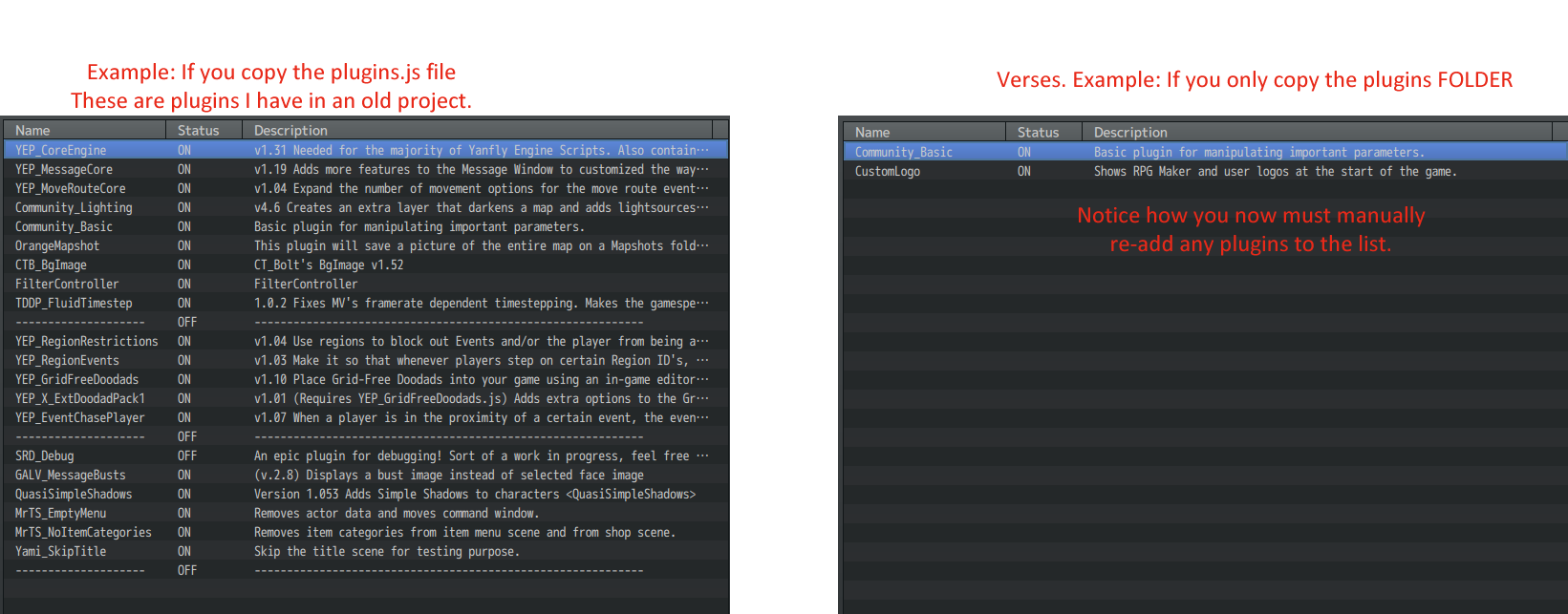
If I’m particularly lazy, I’ll do the same thing for the Tileset Data.
This way, you won’t have to manually re-edit the tileset in the engine for whatever is passable or non-passable one by one for every tileset.
Just be sure to copy and paste the tileset from the old game over to the new one before you do this.
(Click image for larger view)

Of course, there’s nothing wrong with doing everything manually either! This is just a way I do things to make things go by a bit faster.
If you go the manual route of adding plugins to a new game, make sure you’re aware of which order specific plugins need to be in. For instance, a lot of Yanfly/YEP plugins require CORE plugins to be ABOVE specific other plugins to work properly.
If you’re adding new plugins to your game (different from ones you’ve already copied over), then be sure to playtest on the new default map provided to make sure there’s no conflicts with plugins or game-breaking bugs or errors.
Another thing I like to do before starting a new game, is going in and manually adjusting the default audio volume.
For things like START or ACCEPT, CANCEL etc. will be VERY LOUD (at least for me personally) so you may want to toggle that as well before playtesting your project.
(Click image for larger view)
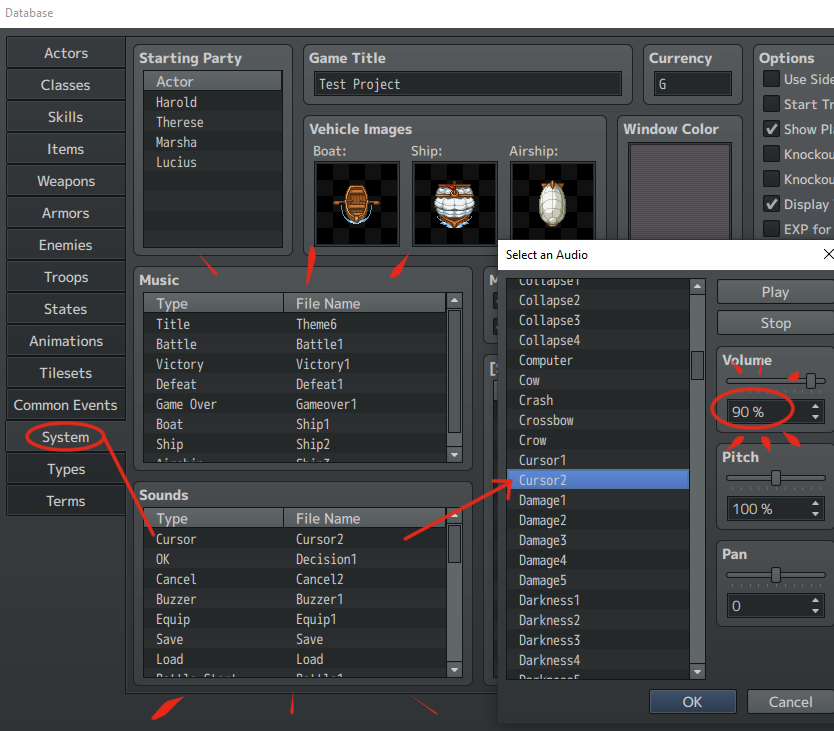
For me, I tend to start a map by filling it in with a floor tile like grass (as default) or indoor flooring, and build my world around it- a lot of my ideas come to me for games based on whatever I “draw” in the engine.
Do I want this character to live in a fantasy world? Do they live in a modern world? Is their home big or cramped? Do they live near nature? These things float around in my mind as I just kind of do my own thing.
(Click image for larger view)
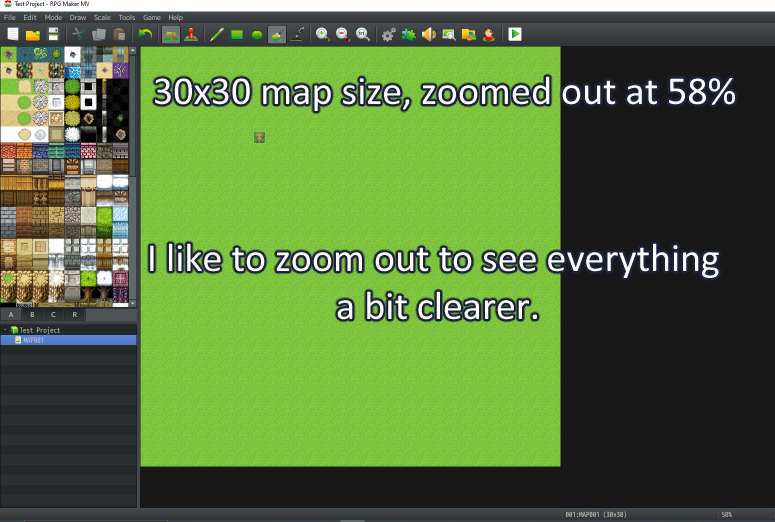
When working on a new map, I’ll shut my brain off and just play around with the tiles and see what looks nice to me, like a dollhouse. It doesn’t have to have anything specific behind it or deep lore right off the bat either.
Sometimes it’s nice just making a little room or area as a warm-up! When I make a room, I like to picture what the outside of the room or house would look like, or vice versa, and make a new map to begin designing that as well.
(Click image for larger view)
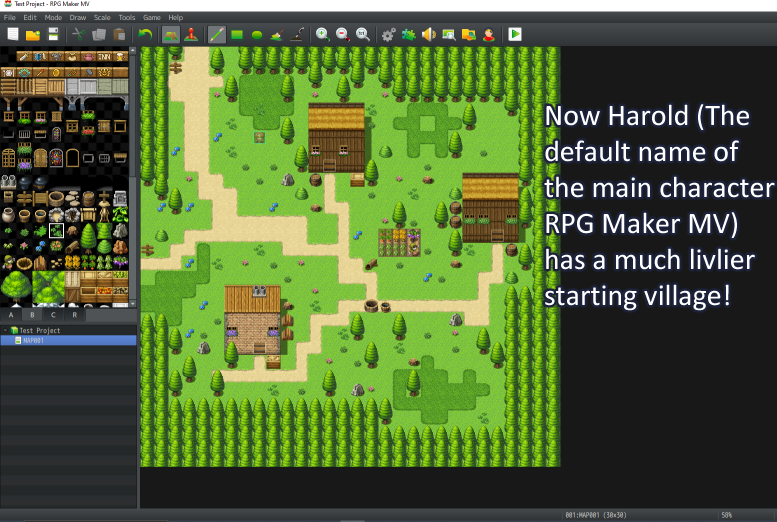
Bam! You have your own little world right here! It may be small and simple, but you’re already on your way to storybuilding! Of course, you can do whatever feels right for YOU personally!
Maybe you already have an idea of what you want your world to look like! Maybe you’ve already sketched out a layout and already know what you’re doing- that’s totally fine too!
For me, if I don’t already have a slight inkling of what story I want to make, I’ll just make random maps with random items or buildings and see if something gets me brainstorming.
I tend to make my new maps at least 30 x 30, and add or subtract when necessary.
Just be sure to save often, and be aware that if you shrink your map too much, and try to expand it again, you’ll lose the design progress you’ve made to your map!
Occasionally, for inspiration, I’ll play some of my favorite RPG Maker games to get a feel of a layout I really like, or to see what developers used to make their worlds feel more lived in- even if they use the default assets!
(Click image for larger view)
(Screenshot of the game "Leave" By Gustav/Astral (Outgoing link) )
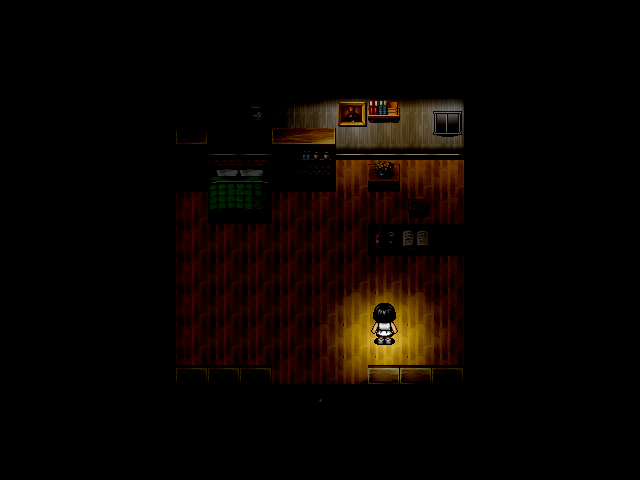
My major weakness is interiors without much flair or bare-walls. I often get carried away and either add too much to the background or surrounding area,
or too little- leaving things feeling a bit bland. It can be hard finding a balance that you’re ok with personally.
(Click image for larger view)
(Screenshot of a bedroom from my game Azure Hue (Outgoing link) )
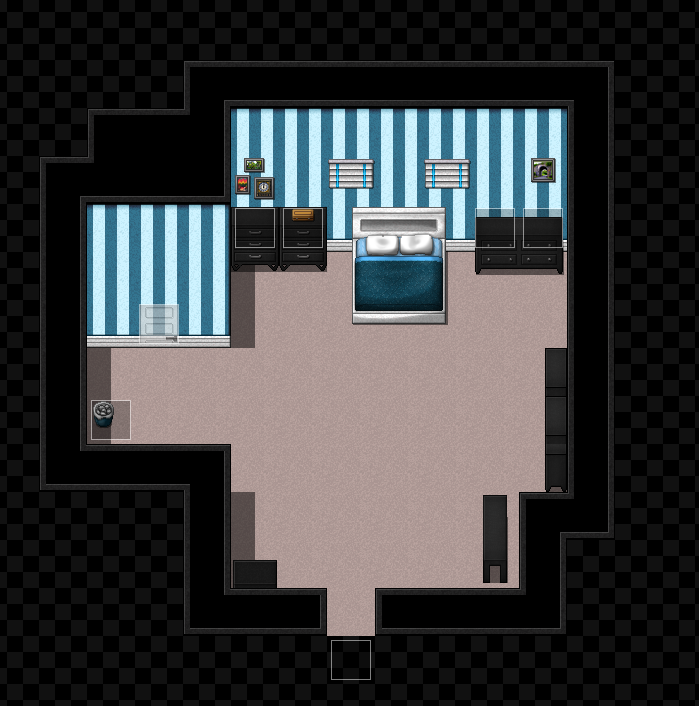
Don’t be afraid to ask pals for assistance in this regard! I often ask my brother or my husband what they think about an interior or exterior design to gauge input.
I’m sure you don’t need me to tell you this, but don’t worry too much about filling in all the little nooks and crannies to a room you’re not satisfied or finished with.
There are even times where I don’t even decorate a room till much later in development!
(Click image for larger view)
(Screenshot from my game Azure Hue)
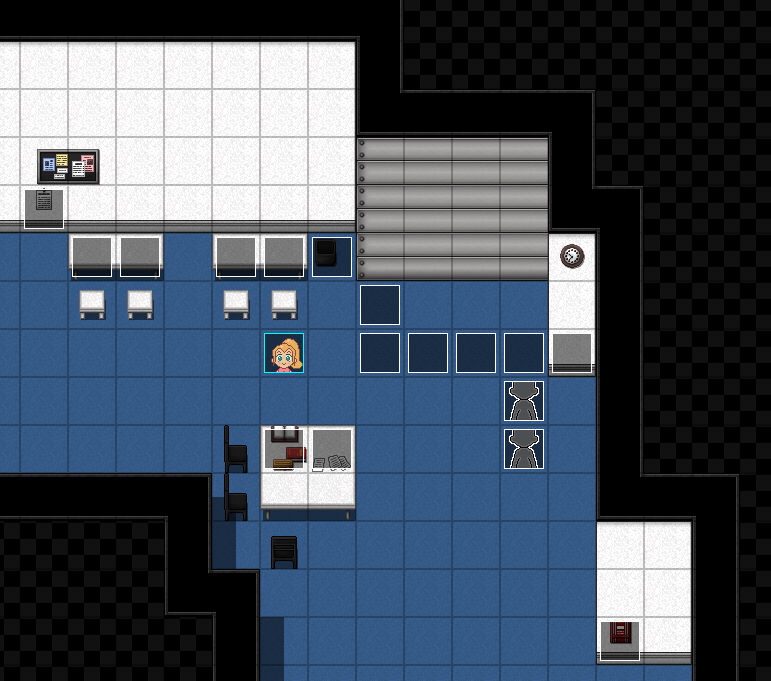
The picture below is of the same map, but using the Yanfly YEP_GridFreeDoodads plugin, I was able to make the room look a bit more lived in.
(Click image for larger view)
(Screenshot from my game Azure Hue)
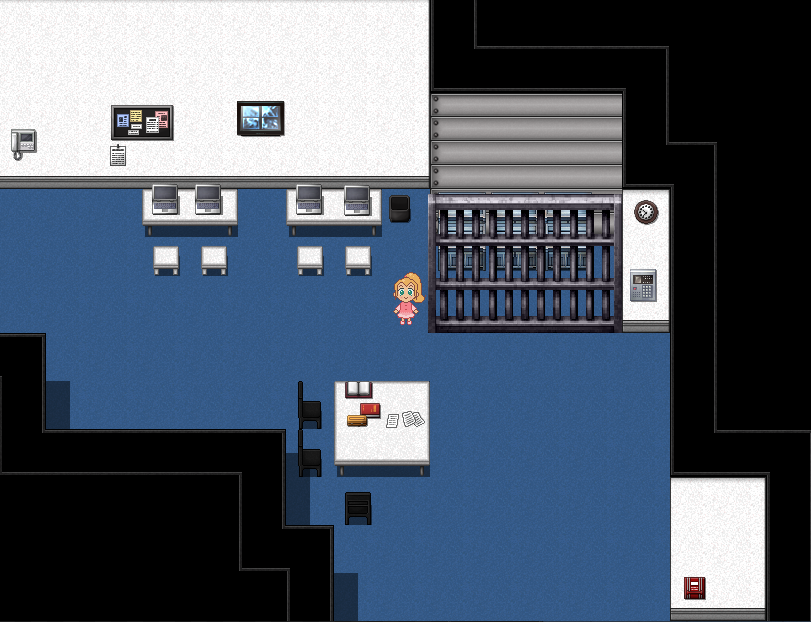
Pro tip: If you’re using MV: PLEASE NAME YOUR SWITCHES AND EVENTS!! This can get annoying, I know but TRUST ME OK?
You don’t wanna be stuck with a ton of different events or switches and come back to the game wondering what does what.
(This doesn’t have to apply to repetitive events like lights or something similar,
but it can definitely help if you’re using something like the Set Movement Route and you have a ton of unnamed events.)
(Click image for larger view)
(Screenshot from my game Azure Hue)

When adding common events, specifically the footstep sound effect common events* in my games, I like to lay them out in a checkerboard pattern like so.
(Click image for larger view)
(Screenshot from my game Azure Hue)
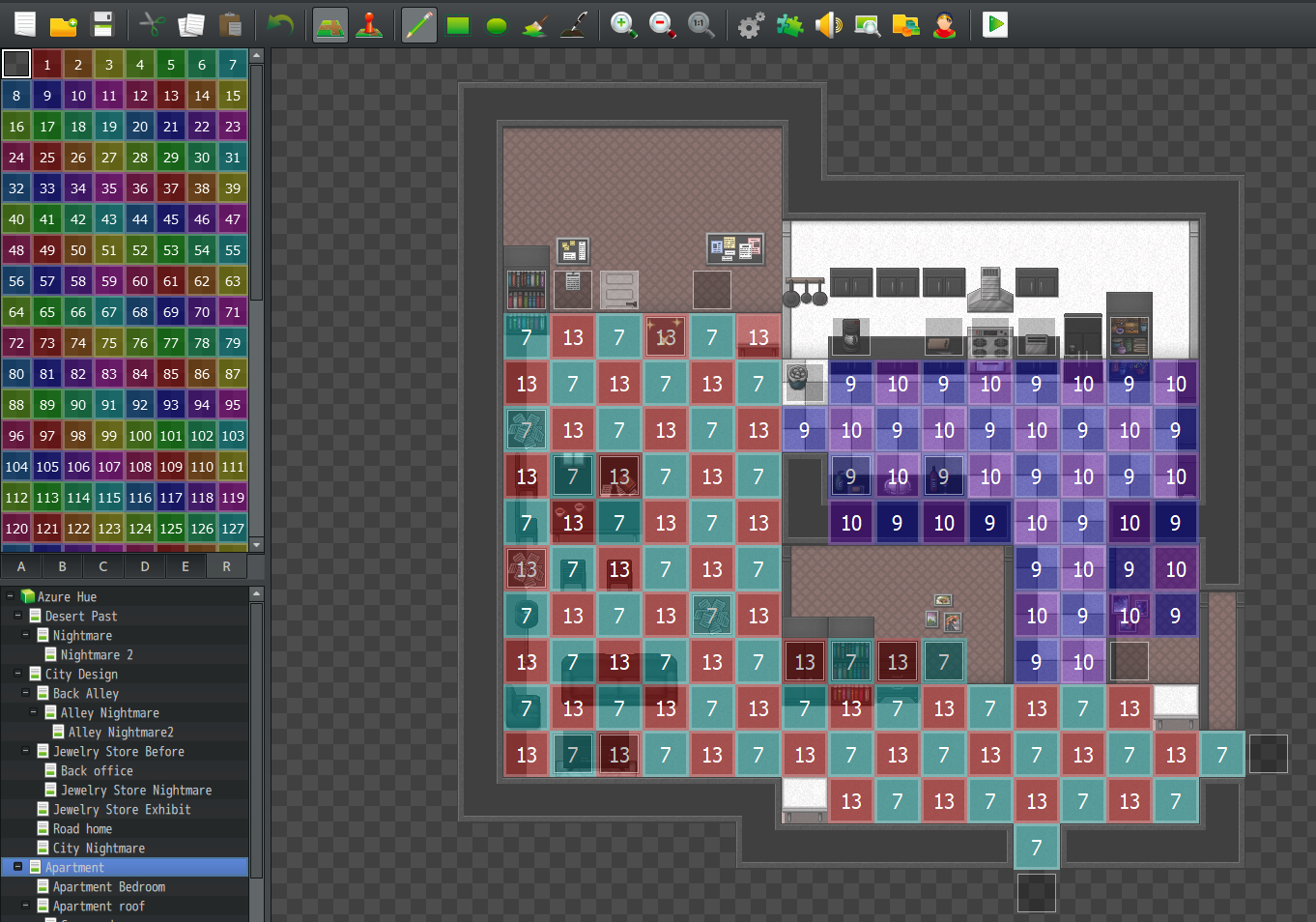
*From the Yanfly / YEP_RegionEvents Plugin! Their website has useful tools and video(s) for assistance on using this plugin!
http://www.yanfly.moe/wiki/Region_Events_(YEP) (Outgoing Link)
The difference between these is in the pitch.(Ex: tile 7 is "x sound" at 70% pitch and tile 13 is "x sound" at 100% pitch) In this instance, I have different tile sound effects
for whether the player steps on "carpeted flooring" or "tile flooring", like in a kitchen.
This can feel like you can really hear the character’s footsteps one after the other.
It also feels more…”alive” I guess? It definitely adds some form of depth in the game,
especially if there are different sound effects for different tiles (grass sounds vs. pavement sounds etc.).
I think that's all for the "Getting Started" segment! Thank you for reading this far! There's so much to making a game, especially in
RPG Maker. I do hope you'll give it a try! The engine itself comes with a built-in Tutorial, so feel free to use
that as you wish.
I'll see ya'll in the next section! Thank you!